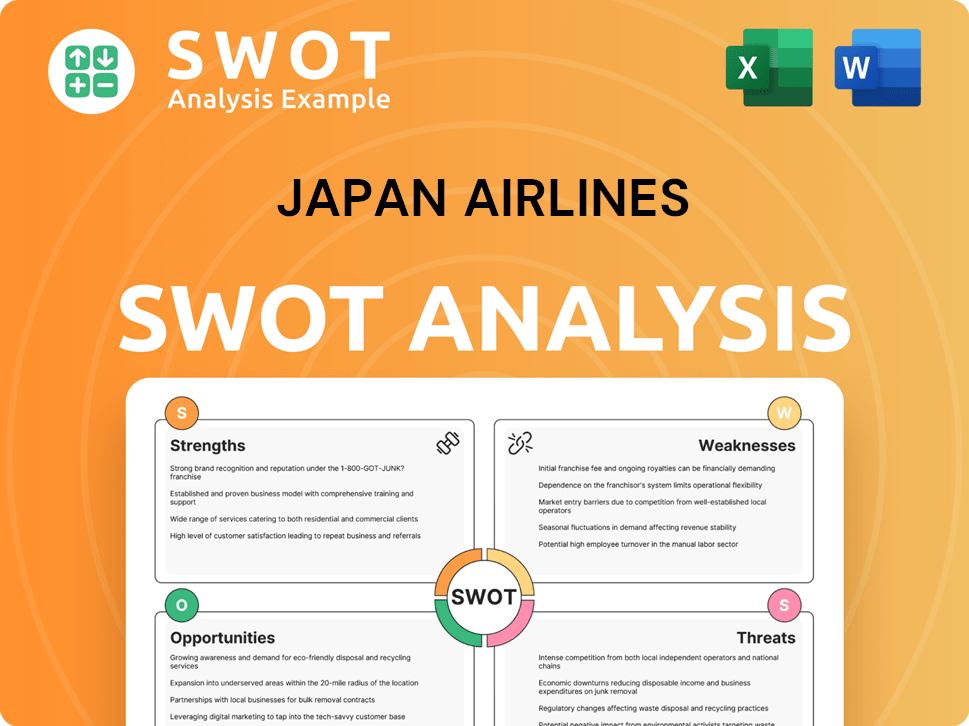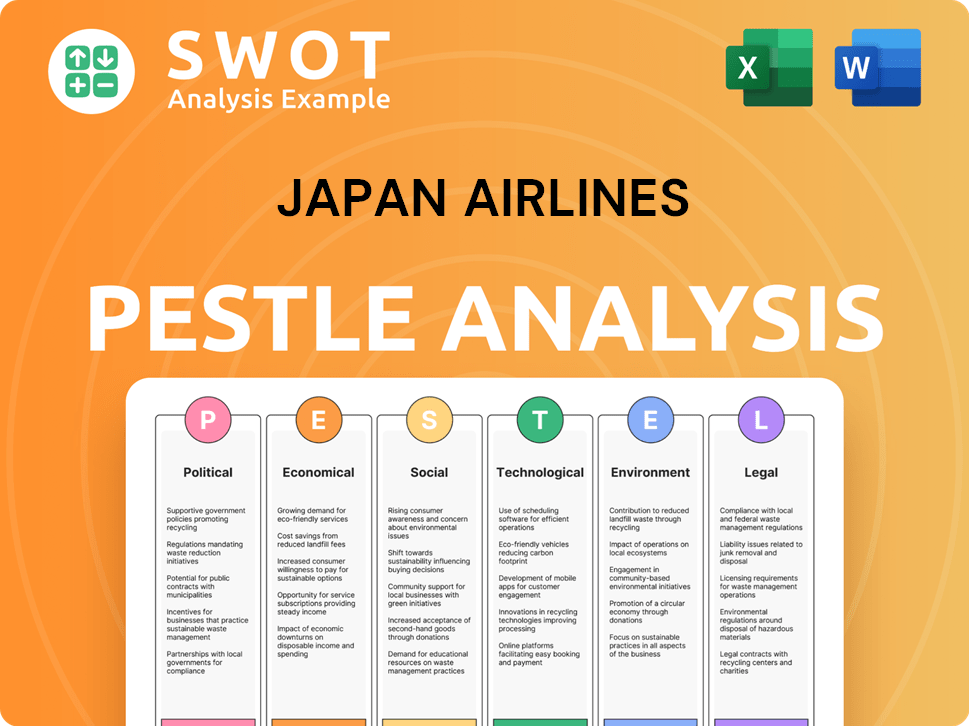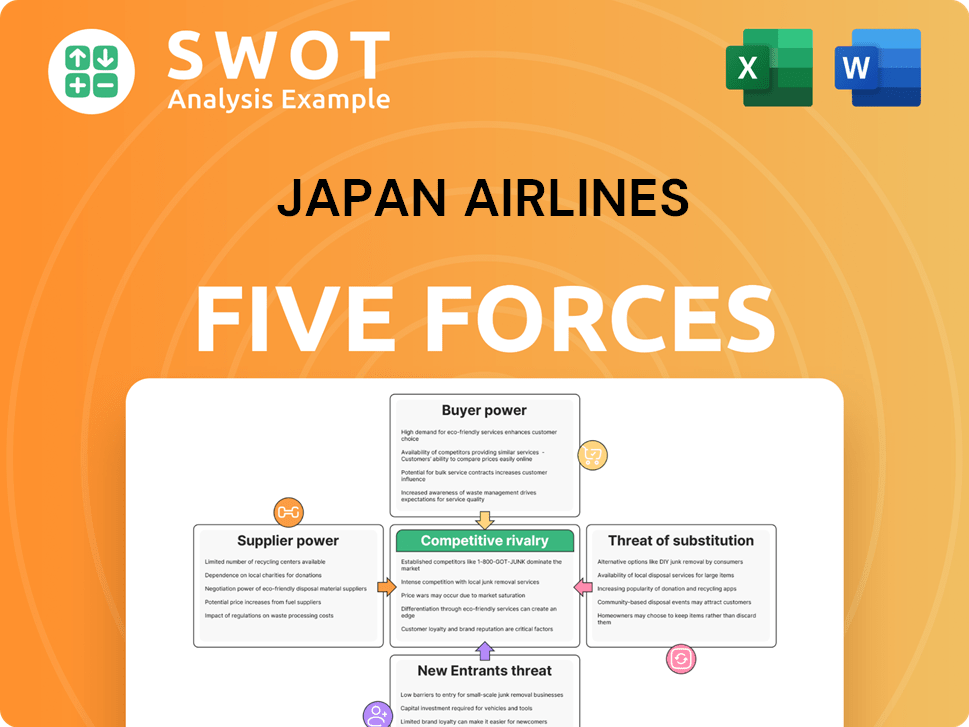Japan Airlines Bundle
How Does Japan Airlines Stay Airborne Financially?
Japan Airlines (JAL) isn't just soaring through the skies; it's also achieving remarkable financial heights, as demonstrated by its record-breaking revenue in FY2024-2025. With a significant surge in international passenger numbers and a strengthened net income, JAL showcases a robust recovery and strategic prowess in a dynamic global market. But how does this leading airline actually operate, and what drives its continued success?

To truly understand JAL's impressive performance, we must explore its core operations, from its extensive flight routes and Japan Airlines SWOT Analysis, to its commitment to sustainability. This analysis will uncover the secrets behind JAL's resilience, examining its strategies for navigating challenges within the Japanese aviation sector and maintaining its position as a global leader. Delving into JAL's financial performance, fleet, and customer service will provide a comprehensive view of how it continues to thrive.
What Are the Key Operations Driving Japan Airlines’s Success?
Japan Airlines (JAL) creates and delivers value through its air transportation services. These include scheduled passenger and cargo operations, complemented by low-cost carrier (LCC) services and non-aviation businesses. JAL serves a diverse customer base, including individual and business travelers, and cargo clients.
The airline operates across Asia, the Americas, Europe, and Oceania. JAL's core operations revolve around managing a large fleet, which as of July 2024, includes 227 aircraft. The airline is constantly updating its fleet with fuel-efficient aircraft to improve operational efficiency and expand international capacity.
JAL's distribution network includes direct sales, online platforms, and partnerships with travel agencies. As a member of the Oneworld alliance, JAL extends its reach through codeshare agreements and interline partnerships with other global airlines, offering seamless connections and a wider range of travel options. For example, a joint business partnership with Garuda Indonesia commenced on April 1, 2025, expanding codeshare flights across over 34 routes in Indonesia and Japan.
JAL manages a fleet of 227 aircraft as of July 2024, serving 384 airports across 64 countries/regions. The airline is actively upgrading its fleet with fuel-efficient aircraft like the Airbus A350-1000 and Boeing 787-9 Dreamliners. The Airbus A350-1000 is being deployed on key routes such as Haneda-Paris and Haneda-Los Angeles starting May 2025.
JAL focuses on providing a seamless and comfortable travel experience. This includes unique amenities and personalized services, such as dedicated check-in counters and exclusive lounges. This commitment to customer satisfaction, alongside continuous innovation and a focus on safety, enhances customer benefits and market differentiation.
JAL utilizes direct sales channels, online platforms, and partnerships with travel agencies. As a member of the Oneworld alliance, JAL extends its reach through codeshare agreements and interline partnerships. A joint business partnership with Garuda Indonesia commenced on April 1, 2025, expanding codeshare flights across over 34 routes in Indonesia and Japan.
JAL's supply chain involves extensive maintenance, repair, and overhaul (MRO) operations. This is to ensure a high operational reliability rate, aiming for 99.5% in 2024. This focus on operational excellence is crucial for maintaining safety and efficiency.
JAL's core operations are centered around scheduled passenger and cargo services. The airline also operates low-cost carrier (LCC) services and non-aviation businesses. JAL's commitment to customer service and operational efficiency is a key differentiator.
- Fleet modernization with fuel-efficient aircraft.
- Extensive MRO operations to ensure high reliability.
- Strategic partnerships to expand its network.
- Focus on customer service through personalized experiences.
Japan Airlines SWOT Analysis
- Complete SWOT Breakdown
- Fully Customizable
- Editable in Excel & Word
- Professional Formatting
- Investor-Ready Format

How Does Japan Airlines Make Money?
Japan Airlines (JAL) employs a multifaceted approach to generate revenue, encompassing passenger services, cargo operations, and non-aviation businesses. This strategy allows JAL to adapt to market changes and maximize profitability. For the fiscal year 2024-2025, the company reported consolidated revenues of JPY 1,844 billion, demonstrating the effectiveness of its diversified revenue streams.
The airline's financial success is driven by a combination of its full-service carrier (FSC) and low-cost carrier (LCC) operations, along with strategic initiatives in ancillary services and loyalty programs. These strategies are crucial for maintaining a competitive edge in the dynamic aviation industry. JAL's focus on customer satisfaction and operational efficiency further supports its revenue generation and monetization strategies.
JAL's revenue streams are diverse, ensuring financial stability and growth. The main sources include passenger services, cargo and mail, the LCC segment, and non-aviation businesses. Each segment contributes significantly to the overall financial performance, with passenger services being the largest revenue generator.
The primary revenue streams for Japan Airlines are carefully managed to ensure financial health. These streams include passenger services, cargo and mail, the LCC segment, and non-aviation businesses. The airline's ability to diversify its revenue sources is a key factor in its financial success. For more insights, check out the Marketing Strategy of Japan Airlines.
- Passenger Services: This is the largest revenue contributor, including both international and domestic flights. In FY2024-25, international passenger numbers increased by 14.4%, boosting revenue significantly. Domestic passenger revenue also rose, with a record-high domestic load factor of 82.9% in Q4 FY2024. Revenue from full-service operations climbed 9.8% to JPY 1,451.8 billion in FY2024.
- Cargo and Mail: JAL's cargo operations contribute through high-value shipments. New routes, such as Tokyo-Narita (NRT)–Hanoi (HAN), further enhance this revenue stream.
- Low-Cost Carrier (LCC) Segment: JAL's LCCs, like ZIPAIR and Spring Japan, have shown substantial growth. ZIPAIR and Spring Japan saw a 39.1% revenue increase in FY2024-25, with Spring Japan achieving full-year profitability. This segment increases overall revenue and EBIT from non-full-service carriers.
- Non-Aviation Businesses: This segment includes mileage/finance and commerce activities, ground handling, and travel services. Revenue from Mileage/Finance and Commerce activities increased by 4.8% in Q1 FY2025. Ground handling services also contribute significantly, with a 12.8% year-on-year revenue increase in FY2024, reaching JPY 252.2 billion.
JAL employs various monetization strategies to maximize revenue and enhance customer satisfaction. These strategies include ancillary services, loyalty programs, tiered pricing, premium offerings, and strategic partnerships. These are designed to increase revenue and customer loyalty.
- Ancillary Services: JAL maximizes revenue through value-added services, such as in-flight Wi-Fi, premium seat upgrades, and excess baggage allowances.
- Loyalty Programs: JAL Miles offers exclusive benefits and rewards to frequent travelers. A new partnership with Rakuten, launched in 2024, allows point exchange, expanding customer engagement.
- Tiered Pricing and Premium Offerings: JAL offers different cabin classes (First Class, Business Class, Premium Economy, and Economy) with varying prices and amenities. The introduction of JAL First Class on routes like Tokyo Haneda-Miyako in August 2025 enhances premium offerings. JAL was recognized as the 'World's Best Premium Economy Class' at the Skytrax World Airline Awards Ceremony 2024.
- Strategic Partnerships: Collaborations with other airlines and travel companies expand JAL's network and offerings, boosting revenue through codesharing and increased passenger flow.
Japan Airlines PESTLE Analysis
- Covers All 6 PESTLE Categories
- No Research Needed – Save Hours of Work
- Built by Experts, Trusted by Consultants
- Instant Download, Ready to Use
- 100% Editable, Fully Customizable

Which Strategic Decisions Have Shaped Japan Airlines’s Business Model?
Japan Airlines (JAL) has navigated significant challenges and strategic shifts, fundamentally changing its operations and financial health. A pivotal moment was the bankruptcy filing in January 2010, which led to a successful restructuring and relisting on the Tokyo Stock Exchange in September 2012. This turnaround has positioned JAL for renewed growth and expansion in the competitive landscape of Japanese aviation.
In recent years, JAL has demonstrated a strong recovery, marked by impressive financial results. For the fiscal year ending March 2024, JAL achieved record-breaking revenue of ¥1.52 trillion, a 50% increase from the previous fiscal year, driven by a sharp increase in passenger numbers. The fiscal year 2024-2025 saw consolidated revenues reach JPY 1,844 billion, an 11.6% year-on-year increase, the highest since its relisting. The company's net income for FY2024 surged by 178% to JPY 95.5 billion.
JAL's journey includes a significant bankruptcy filing in 2010, followed by a successful restructuring and relisting. This strategic move enabled the airline to regain financial stability and confidence in the market. The recovery has been marked by impressive financial results and strategic initiatives.
JAL reported record revenues of ¥1.52 trillion for the fiscal year ending March 2024, a 50% increase. The fiscal year 2024-2025 saw consolidated revenues reach JPY 1,844 billion, an 11.6% year-on-year increase. Net income for FY2024 surged by 178% to JPY 95.5 billion.
JAL is modernizing its fleet with fuel-efficient aircraft and expanding its international route network. Diversification into non-aviation businesses and sustainability initiatives are also key. These moves aim to improve operational efficiency and reduce environmental impact.
JAL focuses on exceptional customer service and benefits from strategic partnerships within the Oneworld alliance. The airline is also exploring technological advancements to enhance customer experience and streamline operations. These advantages help JAL maintain a competitive edge in the market.
JAL's strategic moves are crucial for its growth and sustainability. These include fleet modernization, network expansion, diversification, and sustainability initiatives. These strategies are designed to enhance operational efficiency and reduce environmental impact.
- Fleet Modernization: Upgrading with fuel-efficient aircraft like the Airbus A350-1000 and Boeing 787-9 Dreamliners. By FY2025, JAL expects to have 11 A350-1000s operating on routes to the US and Europe.
- Network Expansion: Launching new routes, such as Tokyo Narita (NRT)-Chicago (ORD) on May 31, 2025, and increasing frequencies on existing routes.
- Diversification: Expanding into non-aviation businesses, including collaborations with Rakuten and the launch of the 'JAL Corporate SAF Program'.
- Sustainability Initiatives: Aiming for net-zero greenhouse gas emissions by 2050 and a 10% SAF usage in its fuel mix by 2030, with an interim target of 1% by 2025.
JAL's commitment to customer service, strategic partnerships, and technological innovation is key to its competitive advantage. For a deeper understanding of the airline's target market, you can explore the Target Market of Japan Airlines.
Japan Airlines Business Model Canvas
- Complete 9-Block Business Model Canvas
- Effortlessly Communicate Your Business Strategy
- Investor-Ready BMC Format
- 100% Editable and Customizable
- Clear and Structured Layout

How Is Japan Airlines Positioning Itself for Continued Success?
Japan Airlines (JAL) holds a significant position in the global aviation market, consistently ranking among the top carriers. In 2024, it demonstrated its strength by increasing its market share in international travel to 22%. JAL's strong brand reputation and customer loyalty, reinforced by its '5 Star' certification for seven consecutive years, are key assets. The commercial aviation segment dominates the Japanese aviation market, accounting for approximately 58% of the market share in 2024, driven by increasing air passenger traffic.
Despite its strong position, JAL faces several challenges, including market volatility, competitive pressures, exchange rate fluctuations, rising operating costs, and human resource shortages. However, the company is proactively addressing these issues through strategic initiatives focused on fleet modernization, network expansion, business model reforms, and sustainability commitments. This strategic approach aims to ensure sustained growth and profitability for the future.
JAL is a leading global airline, with a strong presence in the Japanese aviation market. Its '5 Star' certification and customer loyalty are key differentiators. The airline's market share in international travel reached 22% in 2024, demonstrating its competitive strength. For more information on the strategic direction of the company, read about the Growth Strategy of Japan Airlines.
JAL faces risks such as market volatility, competitive pressures, and exchange rate fluctuations. Rising operating costs, including fuel and workforce investments, also pose challenges. The aviation industry's human resources shortage could further impact operations.
JAL's future outlook is cautiously optimistic, with strategic initiatives driving growth and profitability. These include fleet modernization, network expansion, business model reforms, and sustainability commitments. The company projects revenue of JPY 1,977.0 billion, EBIT of JPY 200.0 billion, and net profit of JPY 115.0 billion for FY2025-26.
JAL plans continued fleet upgrades with fuel-efficient aircraft and network expansion. The airline aims to strengthen partnerships within the Oneworld alliance. Expanding LCC and non-aviation businesses, such as mileage/finance and commerce, is a priority. JAL is committed to achieving net-zero CO2 emissions by 2050.
JAL's financial forecasts for FY2025-26 include revenue of JPY 1,977.0 billion, EBIT of JPY 200.0 billion, and net profit of JPY 115.0 billion. The company is focusing on sustainability, aiming to replace 1% of total fuel with Sustainable Aviation Fuel (SAF) by 2025, increasing to 10% by 2030.
- Continued fleet upgrades
- Network expansion and partnerships
- Business model reforms and diversification
- Sustainability initiatives
Japan Airlines Porter's Five Forces Analysis
- Covers All 5 Competitive Forces in Detail
- Structured for Consultants, Students, and Founders
- 100% Editable in Microsoft Word & Excel
- Instant Digital Download – Use Immediately
- Compatible with Mac & PC – Fully Unlocked

Related Blogs
- What are Mission Vision & Core Values of Japan Airlines Company?
- What is Competitive Landscape of Japan Airlines Company?
- What is Growth Strategy and Future Prospects of Japan Airlines Company?
- What is Sales and Marketing Strategy of Japan Airlines Company?
- What is Brief History of Japan Airlines Company?
- Who Owns Japan Airlines Company?
- What is Customer Demographics and Target Market of Japan Airlines Company?
Disclaimer
All information, articles, and product details provided on this website are for general informational and educational purposes only. We do not claim any ownership over, nor do we intend to infringe upon, any trademarks, copyrights, logos, brand names, or other intellectual property mentioned or depicted on this site. Such intellectual property remains the property of its respective owners, and any references here are made solely for identification or informational purposes, without implying any affiliation, endorsement, or partnership.
We make no representations or warranties, express or implied, regarding the accuracy, completeness, or suitability of any content or products presented. Nothing on this website should be construed as legal, tax, investment, financial, medical, or other professional advice. In addition, no part of this site—including articles or product references—constitutes a solicitation, recommendation, endorsement, advertisement, or offer to buy or sell any securities, franchises, or other financial instruments, particularly in jurisdictions where such activity would be unlawful.
All content is of a general nature and may not address the specific circumstances of any individual or entity. It is not a substitute for professional advice or services. Any actions you take based on the information provided here are strictly at your own risk. You accept full responsibility for any decisions or outcomes arising from your use of this website and agree to release us from any liability in connection with your use of, or reliance upon, the content or products found herein.